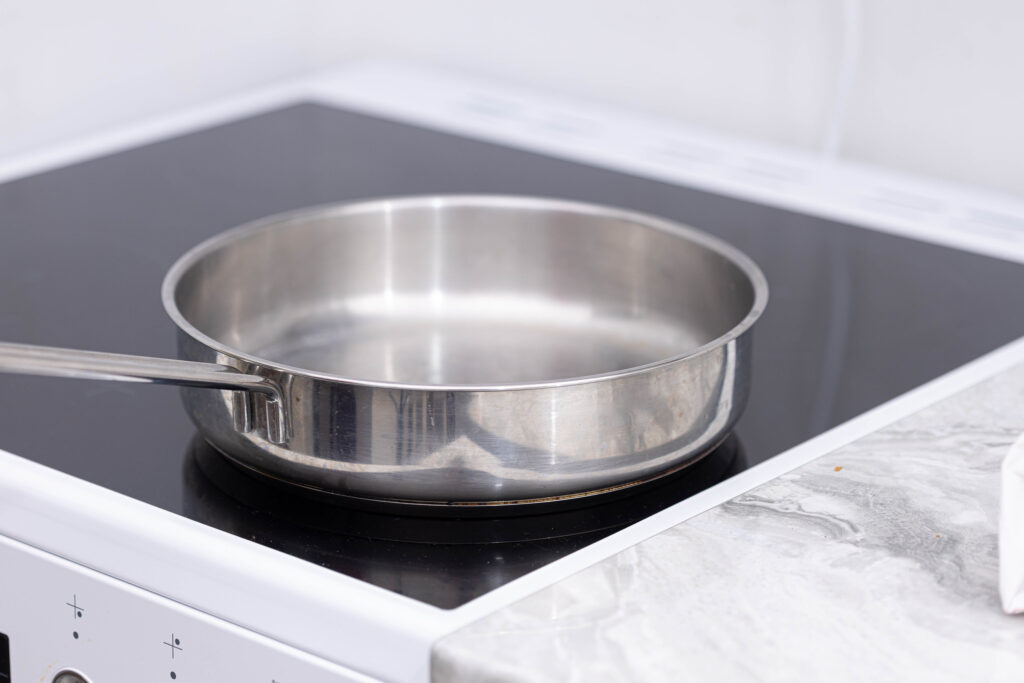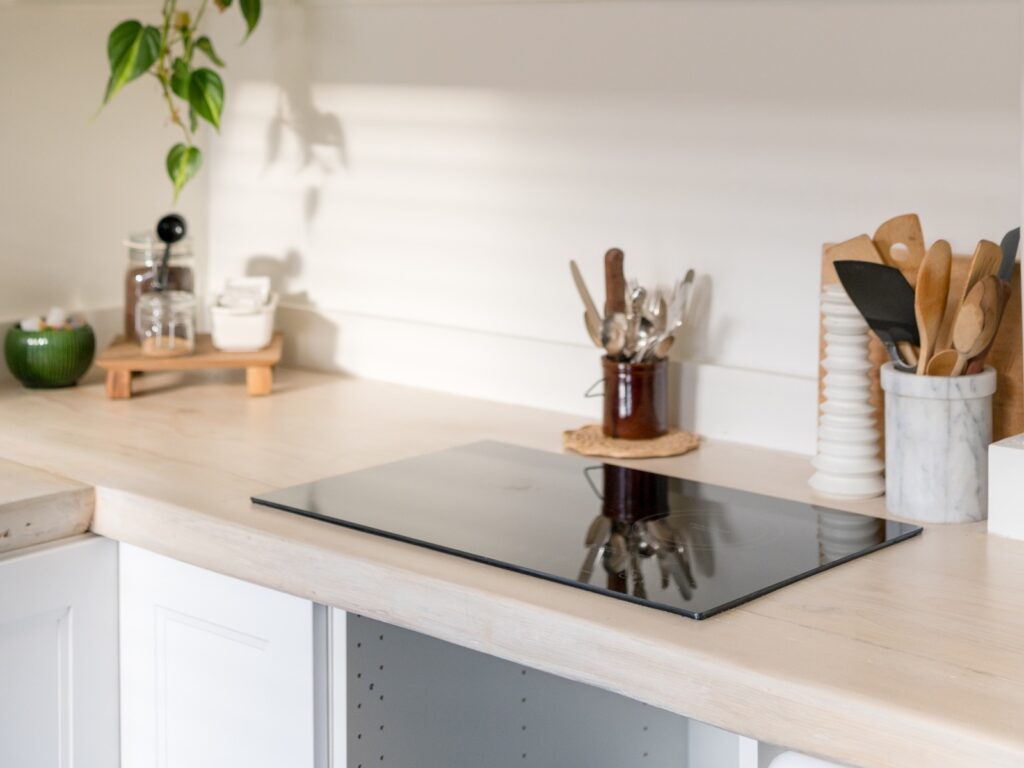Faster cooking, cooler kitchens, and a methane-free home
If it’s time to replace your gas stove, or you’ve decided you’re no longer comfortable with indoor air pollution, you could be comparing an induction cooktop (or range) to gas.
If you’re willing to adapt your cooking style just a bit, there is almost no downside to induction. It’s faster, more efficient, and safer. It produces less ambient heat in your home and no harmful fumes. And it removes one more point of natural gas from your home, reducing your carbon impact and eliminating potential methane leaks.
Induction stoves cost a bit more than gas, at least upfront, but given how much worse gas stoves are for human health, we think this is well worth the cost.
What is induction cooking? How is it different from gas?
A gas stove lights natural gas on fire, then controls the amount of gas flowing to that flame, either underneath a burner or inside a stove. That’s conduction: gas burns, the heat is conducted to your cookware, and your cookware then cooks your food.
Induction, by comparison, is direct heat. An electromagnet sitting just underneath the ceramic flat surface creates a magnetic field that reaches the pan sitting on it. That field induces a reaction with the metals in your pan that resist it, which warms the pan up and then cooks your food.
Induction has quite a few advantages over gas, including:
- Faster cooking, especially boiling liquids
- Faster response to temperature changes
- Less waste heat (cooler kitchen)
- Safer cooking without exposed flames
- Built-in timers and safety features against leaving a burner on
- Easier clean-up
- Eliminating the indoor air pollution of gas stoves
- No gas line capable of leaking
- Electrifying your home toward fewer carbon emissions
For far more information on induction cooking, and our recommendations on how to buy the right stove, check out our guide to induction stoves and cooktops.
Costs
Upfront purchase
New induction stoves cost more than new gas stoves. Some of this is to be expected, given that they’re a newer product category, and have more advanced capabilities (especially since most come with convection-driven, or “air fry,” electric ovens).
Shopping at big-box appliance stores, we saw a range of $550-$1,600 for a 30-inch or slide-in gas stove, at 5-6.5 cubic feet in size. There are certainly more expensive stoves, but we cut off the top range where prices started to jump for unique looks or attention-getting features.
The same sizes of induction stoves were $1,200 to $2,000 (similarly limited to mainstream models without expensive upgrades). More expensive induction stoves tend to start at $3,000.
It’s worth noting, too, that many appliance stores and chains may not have induction models available for immediate, local pick-up and delivery—at least at this stage in induction’s growth. You can likely get delivery for free on such a significant online purchase—and possibly even installation, if your kitchen is ready for it.
Installation
Some people won’t need to pay much to install their stove, gas or induction, depending on what was there before. If your home already has a gas stove, buying another gas stove is the path of least resistance. Similarly, it’s easier to install an induction stove where an electric stove was before.
Induction stoves, like electric, require a dedicated 220-volt outlet, connected to a 40-50-amp circuit breaker. If you’re moving on from gas, you may need to install high-capacity wiring, a new outlet, and, potentially, upgrade your electrical panel. Finally, you will want to cap your gas line.
This is likely work for a licensed electrician (and plumber, if a gas cap is needed), and the costs would depend on your existing wiring and panel, the distance from the kitchen to the panel, and other variables in your home.
It’s not too likely, but if you’re choosing between induction and a gas stove for a home that doesn’t yet have a stove: don’t. Natural gas prices are soaring and volatile at the time of publication. Gas stoves produce potent greenhouse gasses like methane, which cause climate change. And probably worst of all, gas stoves produce harmful indoor air pollutants that dramatically increase the risk of respiratory illnesses like asthma.
Adding a gas line to a kitchen now, just for the sake of a gas stove, is not a great investment. If you’re not sold on induction as a cooking technology, you should, at a minimum, buy an electric stove. It’s better for your indoor air quality, for the planet, and if you or someone else wants to switch to induction later, it’s much easier.
Cookware

Image via Marco Verch Professional/Flickr.
Induction cooking requires pots and pans that react to magnetism. The simple test is to see if a magnet is attracted to the bottom; if it sticks, the pan is ready for induction. If not, you’ll need to invest in a few new pans.
Many pots and pans already work with induction, even if they’re not specifically labeled or sold as induction-ready. Cast iron, many kinds of steel (stainless or otherwise), some non-stick pans, and Dutch ovens (which are cast iron coated with glass). Nothing will go wrong if you use the wrong pan; the cooktop will simply give you an error and won’t heat it up.
Cooking techniques
Induction cooking, compared to a gas burner, allows for much faster heat-ups, quicker temperature changes, and safer cooking without flames or burning-hot surfaces. Induction converts 90% of its energy to cooking heat, versus 74% for an electric stove, and 40% for a gas stove.
Because the pan should stay in contact with the burner, you’re better off stirring with a utensil than grabbing the pan and flipping food around (you can still do it, you’ll just see an error and lose the power for a moment).
And the mental timings you might have for your techniques and recipes need adjusting, because your induction cooking will go much faster. You might not have as much time to prepare ingredients while other things are heating, and, at first, you’ll have to watch things more closely, like garlic and onions browning. But having a meal done quicker is certainly a nice perk.
If you choose an induction stove, you’ll get the same kind of oven as electric stoves. Increasingly, that means a stove labeled as offering “air frying.” Air frying is essentially a trendy rebrand of a convection oven, where circulating air provides more even heating and crispy/browned foods than a traditional radiant-heat electric oven. Gas stoves also offer air frying, but, as you might imagine, electric ovens are more consistent and accurate.
Appearance
Induction stoves look remarkably similar to most other stoves. It makes sense: they have the same kinds of oven space as electric or gas, and then the flat-top cooking surface of most modern electric stoves.
One notable change for many induction stoves is that they tend to feature buttons, or touch-sensitive panels, rather than the knobs common to gas stoves. That’s a benefit of the technology—you can set many finer temperatures or power levels on the stovetop than simply nudging a dial where you roughly want it.
But if you prefer the control and feel of dials, or don’t trust touch panels not to break, you can find induction ovens with knobs.
Maintenance, repair, and care
Most of what you’ll need to do to keep an induction stove running are the same as for a gas or electric stove. The inner stove needs regular cleaning. The flat stovetop needs cleaning whenever possible. And ventilation is important, as for any cooking appliance.
Cleaning up an induction stove is notably easier than a gas stove. The heat is inside the pan, not literally flaming up from underneath, so both your stove and your pans pick up fewer marks and burns.
The most significant difference with induction cooktops is their ceramic-glass surfaces. They can scratch or scuff if certain cookware slides around on top of them. While they don’t get nearly as hot as traditional electric cooktops, food can still get crusted onto induction cooktops, if it gets trapped underneath the cookware. And if you drop a too-heavy pot or pan on the cooktop, it could chip, or even shatter. None of this is likely to happen with common, cautious cooking, but it’s worth noting.
Follow your stove’s instructions for the best cleaning and maintenance tips. These will typically involve wiping down when cool with a non-abrasive sponge, or a glass scraper for tough gunk.
Environmental benefits
As noted in our induction stove buyer’s guide, “natural gas” is great marketing for something that is mostly methane, a gas that is 80 times more potent at warming the earth than carbon dioxide. The methane that leaks from gas stoves every year—just the functioning stove, not any gas lines—has the same emissions potential as 500,000 gasoline-powered cars on the road.
Just as importantly, induction stoves run on electricity. The U.S.’ electrical supply has a lot of coal and natural gas behind it, but it’s quickly adding more renewables. By cutting off gas and electrifying your home, you’re setting yourself up (and the future people who own your home) to help move the nation, and world, away from burning fossil fuels for everyday needs.
Health benefits
There have been many studies showing that gas stoves are a major source of indoor pollution. Gas cooking has been shown to increase the risk of asthma in children by 42%. Almost no home in America has the kind of ventilation needed to clear the nitrogen dioxide emissions caused by gas stoves.
Carbon Switch founder Michael Thomas recently measured the contaminants his gas stove was releasing in his house, and was shocked at the direct impact gas cooking had on his household air. You can read more about it in “How bad is my gas stove? (Part Two).”
Are there any downsides to induction?
We’ve heard from some induction stove owners about annoyances with their stoves. One of them summarized the main problem: there isn’t a big enough induction market yet for stove makers to prioritize better interfaces and potential flaw fixes.
A big complaint from one user was the touch controls present on many induction cooktops. Besides beeping responses to every change, the touch controls are often super-sensitive, such that stray liquids from cooking can activate them, or make them difficult to touch properly.
There’s also a downside to induction’s efficiency. Induction cooktops directly activate heat in the pan above them, but the heat doesn’t spread like it would with a gas flame or resistance coil. That means that if you’re cooking something across a pot or pan that’s wider than the cooktop itself, food at the edges of the pan won’t get as much heat. One reader said this was a more noticeable problem on pancake Sundays.
Some stoves also have safeguards that prevent a pan from getting too hot—generally wise, but annoying if you’re trying to sear something.
Is there any reason to go with a gas stove?
If your gas stove has failed, or you’ve decided you’re done with it, now is the time to switch to induction. Buying another gas stove locks your house into gas supply for however long that appliance lasts (probably not as long as you’d hope, but still a matter of many years).
At a minimum, if the higher cost, electrical work, and/or new cookware costs seem too much, or if induction’s style doesn’t suit you, consider switching to a traditional electric oven. It’s the same kind of roasting oven you’d get with an induction stove, anyways, but a resistive coil range.
The only gas stove worth using is one that’s already installed and still functional. Use it until it stops working, then commit to capping that gas pipe with your next stove.
